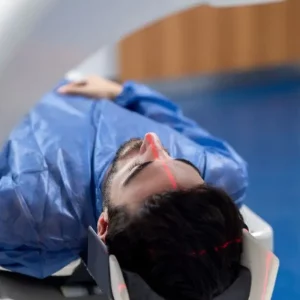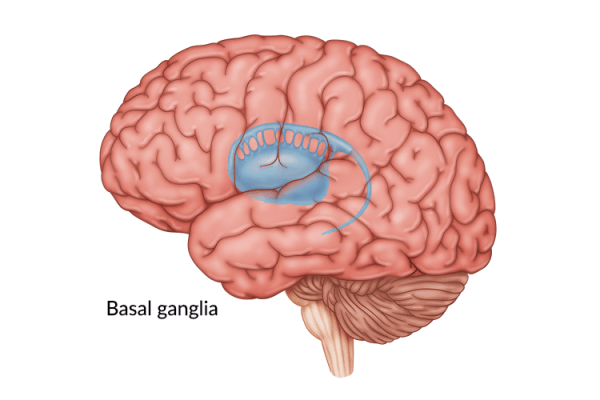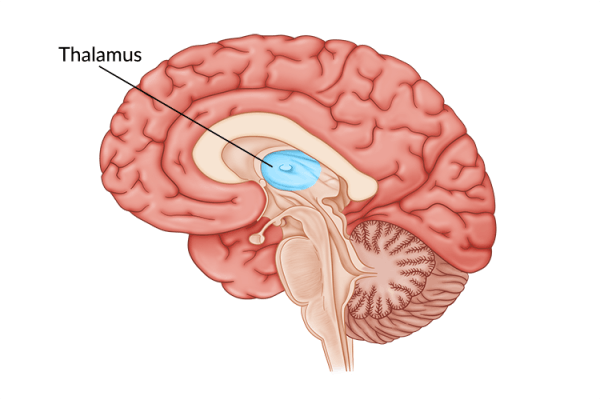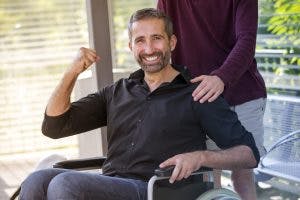Concussions can cause a person to experience vision problems. Fortunately, vision therapy can help relieve many of those symptoms.
Today’s article will show you some of the best eye exercises for concussion that you can do on your own at home.
Eye Exercises for Concussion Recovery
Vision problems can be a secondary effect of brain injury, even mild brain injury such as concussion. Vision problems range from double vision to headaches to bouncing images and other visual changes
The following eye exercises for concussion will strengthen your eye muscles and help restore proper vision.
1. Near/Far Exercises
This eye exercise for concussion patients was designed to train your eyes to transition from looking at an object close up to looking at something far away.
What you need: Two papers with a letter written on each.
- Tape one of your papers on a wall on the opposite side of the room.
- Stand as far away from that wall as you can.
- Hold the other paper about 12 inches from your face.
- Make sure to hold the paper slightly to the side so you can see both the paper on the wall and the paper in your hand simultaneously.
- Next, focus on the paper in your hand until the image is in focus, then look at the paper on the wall until its image is in focus.
- Repeat ten times.
Remember to only use your eyes to move your gaze; do not move your head.
2. Smooth Pursuits
This next exercise will improve your tracking abilities.
What you need: Something that swings, such as a yo-yo.
- Hold the yo-yo at eye level about arms-length away from your face. You may need another person to help you.
- Swing the yo-yo side to side like a pendulum.
- Follow the yo-yo with both eyes. Do not move your head or body.
- Do this for one minute or for as long as you can tolerate.
- Next, swing the yo-yo backward and forwards, away from your face, then back toward you.
- As the yo-yo approaches your face, reach out and touch it when it is directly in front of you.
If this exercise is too difficult at first, try using only one eye at a time (close the other eye or cover it with your hand or an eye patch). Once you can do that without difficulty, you can transition back to both eyes.
3. Fixation Exercises
This eye exercise for concussion recovery was designed to help you regain the ability to focus on close objects.
What you need: Fruit Loops or Cheerios and a pipe cleaner (a shoelace can also work, but tie a knot at the end of it so the loops don’t slip off).
- Closing one eye, hold one fruit loop in your fingers in front of your eye.
- With your other hand, insert the pipe cleaner or shoelace through the loop. Do not move the loop toward the pipe cleaner. The goal of the exercise is to keep your focus on the small hole.
- Once you get the loop on the pipe cleaner, repeat a few more times until you have a row of at least five fruit loops.
- Now, switch to your other eye and do the same thing.
- Once you feel confident with those exercises, try to repeat the activity using both eyes.
For an extra cognitive challenge, have someone say a word that you must find the opposite word to (e.g. day/night; black/white; tall/short, etc.) while keeping your eyes focused on the loop at all times.
4. Saccade Exercises
Saccades refer to the fast and jumpy eye movements required to move eyes from one fixation point to another quickly and accurately. This vision exercise was designed to improve the precision and speed of saccadic eye movements after a concussion. These precise movements are necessary for reading and focusing.
What you need: Two sticky notes and a Sharpie
- Place the sticky notes on the wall about 12 inches apart.
- Write a capital letter on each note.
- Stand about three feet from the wall, then quickly look at the note on your right. Do not move your head.
- Next, look quickly from the right note to the left, then back to the right.
- Repeat back-and-forth eye movements for one minute.
5. Pencil Push-Ups
These eye exercises will help improve your near-sighted vision and your ability to focus on a moving object.
What you need: One pencil.
- Hold the pencil out in front of you at arm’s length. Keep the pencil in a vertical position with the tip pointed up.
- Move the pencil slowly toward your face, keeping your eyes focused on the tip. If you have convergence insufficiency, you will see two pencils instead of one as it gets closer to you. Stop when that occurs.
- Now look away and rest your eyes for two seconds. Next, look back at the pencil. If you still see double, focus until the double vision disappears and you only see one pencil again.
- Move the pencil away from your face while focusing on the tip the entire time. Then repeat.
Practice this exercise for no more than ten minutes at a time, but repeat the exercises 4-5 times daily.
How to Get the Most Benefits from Eye Exercises for Concussion Patients
Consult with your medical team to ensure you have the stamina for the neural stimulation these exercises provide. Then, begin to make these exercises a priority. If you want to experience improvements from these vision exercises, you will need to use a technique therapists call massed practice. That’s a technical term that means doing a lot of exercises several times a day. Only performing each exercise for a few minutes at a time is all that is recommended. However, repeat the sessions 4 or 5 times daily.
That’s because massed practice activates the brain’s natural healing mechanism, neuroplasticity.
But you must be disciplined enough to be consistent with your exercises to get enough stimulation to your brain to have an effect. Don’t just do your exercises every once in a while; try to do them at the same time every day so that you don’t forget to do them.
The more you practice these eye exercises for concussion, the more neural pathways your brain will create in response. That means the exercise will eventually become easier, and your vision will improve.
We wish you luck with the rest of your concussion recovery.










